#Stanko Molnar
Explore tagged Tumblr posts
Text

Macabro (1980) - Japanese chirashi
#macabro#macabre#frozen terror#bernice stegers#stanko molnar#veronica zinny#1980s horror#1980s movies#1980#lamberto bava#horror#chirashi#movie posters
74 notes
·
View notes
Text
youtube
Uma bruxa obsessiva em "A máscara do demônio" (La maschera del demonio, 1989)
#La maschera del demonio#italian horror#lamberto bava#Debora Caprioglio#Mary Sellers#The Mask of Satan#italian movies#italian trash#trash movies#Stanko Molnar#Michele Soavi#Giovanni Guidelli#Stefano Molinari#Eva Grimaldi#Youtube
1 note
·
View note
Text










Macabro (Macabre, 1980)
"I couldn't care less about what she does every night, about her fridge, and not even about her visitors! I don't give a damn! I'm very much aware of Jane's madness, but with all these tales you don't sound too sane either, Mr. Duval!"
#Macabro#Macabre#lamberto bava#italian cinema#films i done watched#Horror film#Blood tw#Nudity cw#Bernice Stegers#Stanko Molnar#Veronica Zinny#Roberto Posse#Ferdinando Orlandi#Fernando Pannullo#Elisa Kadigia Bove#Ubaldo Continiello#Antonio Avati#Roberto Gandus#Pupi Avati#Oliver Hardy voice: Well‚ love of Italian genre films‚ that's another hot mess you've gotten me into!#Actually I've seen this before‚ a decade or more ago‚ and on rewatch I find a film much less sleazy and much less excessive than the one I#Remember. There's some nudity and a little gore but compared to some of its contemporaries it's positively tame#But is it good?? Eh. It's fine. Sadly the younger Bava just didn't have that same grasp of the visually flamboyant or the eerily beautiful#Stegers gives a very fine performance (considering the film she's making) and Molnar is no slouch either. What Bava jnr lacks in#A creative eye he makes up for in his confidence with handling suspense. Very little happens for the vast majority of the film but its#Never boring. He's also ballsy to take such an incredibly worn out trope (what's in the fridge?? We all know what's in the fridge. Every#Single viewer. Even a cat passing a TV playing this would know what's in the fridge) and treating it with such a straight face#Whatever subtlety and lightness of touch Bava employs‚ and whatever goodwill the viewer can muster‚ all goes out the window in what is#Easily one of the stupidest final shots of a film ever. Based on a true story‚ the opening credits claim. I think jot Mr Bava
11 notes
·
View notes
Photo










A Blade in the Dark (1983)
#a blade in the dark#la casa con la scala nel buio#lamberto bava#andrea occhipinti#anny papa#lara naszinski#fabiola toledo#valeria cavalli#michele soavi#stanko molnar#horror#slasher#giallo#80s horror#80s slasher#80s giallo#italian horror#italian slasher#italian giallo#italian cinema#80s fashion#1980s horror movies#slasher movies#gialli#bava#gay horror fan
156 notes
·
View notes
Photo

Padre padrone
#padre padrone#random richards#poetry#poem#poets on tumblr#haiku poem#haiku poetry#gavino ledda#paolo taviani#Vittorio Taviani#biopic#Fabrizio forte#Stanko molnar#child abuse
3 notes
·
View notes
Photo

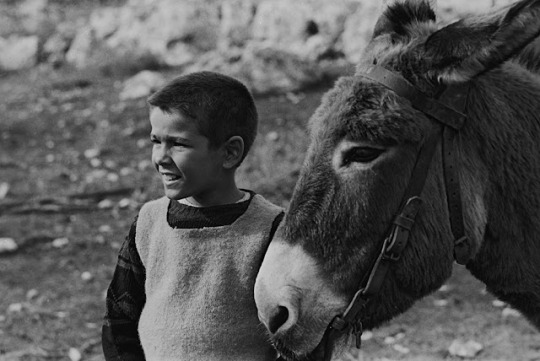
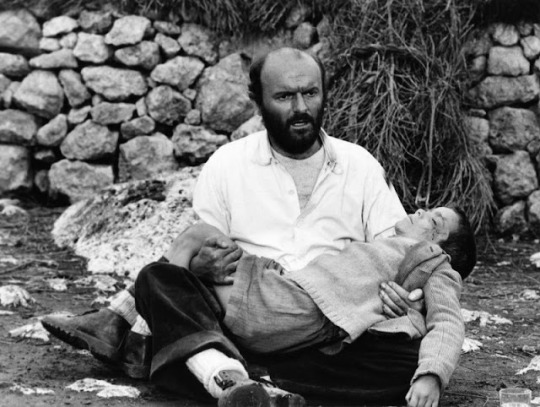
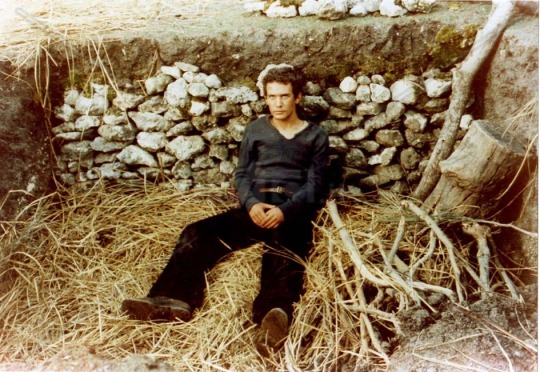
Padre Padrone (Paolo Taviani, Vittorio Taviani, 1977) Cast: Omero Antonutti, Saverio Marconi, Marcella Michelangeli, Fabrizio Forte, Marino Cenna, Stanko Molnar, Nanni Moretti, Gavino Ledda. Screenplay: Paolo Taviani, Vittorio Taviani, based on a book by Gavino Ledda. Cinematography: Marino Masini. Production design: Gianni Sbarra. Film editing: Roberto Perpignani. Music: Egisto Macchi. Two great themes coalesce in Padre Padrone. One is older than Oedipus, the primal conflict of father and son. The other came to the fore in the Enlightenment and the democratic revolutions it spawned; we now call it "social mobility." Poets used to write of flowers "born to blush unseen" and "mute inglorious Milton[s]," the victims of rural isolation, primitive ignorance, societies atrophied in feudal patriarchy. The Tavianis find both themes surviving in rural Sardinia, where Gavino Ledda's father drags him from school at the age of 6 and keeps him in servitude and illiteracy as a shepherd for the next 14 years. Padre Padrone could have been just a feel-good story about Gavino's triumph over his father's sternness and greed -- though the elder Ledda thinks what he's doing is for the son's own good -- but the Tavianis won't let it be just that. Though Gavino, rescued by compulsory military service from isolation and ignorance, becomes a celebrated linguist, an authority on the Sardinian dialect, the actual Gavino Ledda, appearing in a frame story for the dramatized part of the film, lets it be known that he has been permanently marked by his father. The Tavianis also find witty ways of letting the outside world irrupt into the young Gavino's isolation, as when the young shepherd hears an accordion playing and the soundtrack bursts into the overture from Die Fledermaus, a correlative for the world beyond the Sardinian hills. Later, after Gavino has begun to find his vocation but has been forced to return home, the aching beauty of the adagio from Mozart's Clarinet Concerto, to which Gavino is listening, is stifled when the father angrily drowns the radio in the sink. Gavino's feeling of being suppressed by his father finds a correlative when he joins a group of other young men carrying the effigy of a saint to a festival at the church. Hidden underneath the heavy statue, the men plot an escape to be guest-workers in Germany, but the camera pans up to the statue, which has changed to an image of Gavino's father, whose refusal to sign the necessary papers prevents Gavino from fleeing. Padre Padrone was made for Italian TV, and has been restored from 16mm film, so its images are sometimes a little muddy, but it gains real power from its storytelling and from the performances of Omero Antonutti as the father and Saverio Marconi as the grownup Gavino.
3 notes
·
View notes
Text
«Allonsanfàn»
Από 31 Αυγούστου στους κινηματογράφους από τη New Star σε επανέκδοση (more…)
View On WordPress
#Alderice Casali#Allonsanfàn#Benjamin Lev#Biagio Pelligra#Cirylle Spiga#Claudio Cassinelli#Ermanno Taviani#Home#Luisa De Santis#Michael Berger#Raul Cabrera#Renato De Carmine#Roberto Frau#Stanko Molnar#Β��ττόριο Ταβιάνι#Λάουρα Μπέτι#Λέα Μασάρι#Μαρτσέλο Μαστρογιάννι#Μίμσι Φάρμερ#Σταύρος Τορνές
0 notes
Text

Macabro (1980) - Betamax cover
AKA Macabre, Frozen Terror
#macabro#macabre#frozen terror#bernice stegers#stanko molnar#veronica zinny#1980#1980s movies#lamberto bava#horror#betamax#betamax cover
53 notes
·
View notes
Text










Happy Birthday/ Buon Compleanno
Lamberto Bava
In 🇮🇹 & 🇬🇧
🇬🇧
Lamberto bava (born 3 April 1944) is an Italian film director. Born in Rome, Bava began working as an assistant director for his director father Mario Bava. Lamberto co-directed the 1979 television film La Venere d'Ille with his father and in 1980 directed his first solo feature film Macabre.
Bava continued working in the 1980s and collaborated with Dario Argento on films such as Demons. After 1990, Bava's work was predominantly involved with television, such as his Fantaghirò series.
Lamberto's father Mario Bava was a film director known primarily as a director of horror films.
Lamberto's film career began in the mid-1960s working as an assistant director on his father's film Planet of the Vampires.
Lamberto would later collaborate with his father on several of his projects, including Danger: Diabolik (1966), Twitch of the Death Nerve (1971) and Shock On Shock, Lamberto Bava was credited as a screenwriter as well as an assistant director.)
Lamberto Bava had a co-directing credit with his father Mario on the television film La Venere d'Ille, which was an entry in the Il Giorno del Diavolo tv series.
Besides the work he did with his father, Lamberto also contributed to making films with Italian director Ruggero Deodato, such as Ultimo mondo cannibale (1977) and Cannibal Holocaust (1979).
A meeting with director Pupi Avati led to Bava directing his own feature film Macabre in 1980 which was co-written with Pupi and Antonio Avati.
The film stars Bernice Stegers as Jane, a woman who has an affair with a man Stanko Molnar, who dies. After his death, Jane keeps his severed head in her refrigerator and performs erotic acts with it.
According to Lamberto Bava, after seeing Macabre, Mario told him "Now I can die in peace".
Mario actually died later in 1980.
Following the release of Macabre, Lamberto Bava worked in advertising and continued to write stories for potential future film projects.
He was approached by director Dario Argento to assist him with his giallo film Tenebre (1982), wherein Bava is credited as an assistant director.
In 1983, Lamberto Bava directed his second feature film as a director, the giallo film A Blade in the Dark.
A Blade in the Dark was originally developed as a television film shot in four 25-minute segments on a very low budget.
Bava's next two film projects were in different genres than his previous giallo and horror film output. Bava was given a script for Blastfighter,
In 1985, Lamberto Bava reteamed with Dario Argento on the film Demons.
Argento co-wrote and produced Bava's film about a theater showing invitation-only screenings of a horror film. In the theater's lobby, a young woman is scratched by a display in the lobby and transforms into a hideous creature who then attacks other audience members, spreading her demonic infection.
The film was followed by the sequel Demons 2 in 1986.
his next film, Delirium (1987) stars Serena Grandi
Bava returned to television work making several episodes of a series of hour-long films produced by Dario Argento.
Bava's episodes included "E ...di Moda la Morte", "Heavy Metal", "Buona Fine È Migliore Principo", "Giubetto Rosso", "Il Bambino Rapito" and "Babbao Natale".
In July 1986, the company Reteitalia announced that they would new television films for a series titled Brivido giallo would be directed by Bava.
The films were shot between 1987 and 1988 where there were initally going to be a series of five films, it ended up being four.
The first was Cemetery Disturbance which was shown at the Sitges Film Festival in 1987 and Until Death which was released on home video in Germany over a year before its television debut in Italy in 1989.
The other films in the series were The Ogre and Dinner with a Vampire
Bava also did a remake of Black Sunday for the Eurpean television series Sabbath titled La maschera del demonio which premiered in June 1990 at Rome's Fantafestival.
Bava began the 1990s with the fairy tale inspired series Fantaghirò series and its many sequels.....
In 1992, Bava made the film Body Puzzle, which starred Joanna Pacula.
Bava's more recent film work includes L'Impero (2000) and Ghost Son (2006) & Twins (2018)
🇮🇹
Gli inizi di Lamberto furono nell'assistere il padre nel 1965. Durante le riprese del film Schock del 1977 il padre, che non era in buona salute, gli permise di dirigere alcune scene. Il lavoro congiunto continuò nel 1978 con La Venere d'Ille, un film per la televisione facente parte della serie I giochi del diavolo.
Nel 1979 ci fu la svolta che permise al figlio di lavorare da solo nel film Macabro, la cui programmazione nelle sale italiane avvenne due mesi prima della morte del padre.
Il 1980 fu l'inizio della collaborazione nei film di Dario Argento, che confluì nella realizzazione di Dèmoni e Dèmoni 2 - L'incubo ritorna. Sempre per lo stesso regista, fece da assistente regista nel film Tenebre. Nel 1983 dirige il thriller La casa con la scala nel buio
Del 1984 sono invece il film d'azione Blastfighter e l'horror fantascientifico Shark: Rosso nell'oceano, quest'ultimo su soggetto di Luigi Cozzi; in entrambi si firma con lo pseudonimo di John Old Jr. Nel 1986 realizza il film Morirai a mezzanotte, prodotto da Reteitalia, inizialmente pensato per la televisione poi distribuito nei Cinema.
L'anno successivo, nel 1987, dirige il thriller Le foto di Gioia
Dal 1987 si dedicò all'horror televisivo dirigendo due miniserie TV. La prima datata 1988, dal titolo Brivido Giallo, comprendeva quattro capitoli: A cena col vampiro, Una notte al cimitero, Per sempre e La casa dell'orco. A questa fece seguito una seconda, chiamata Alta Tensione, composta da altre quattro produzioni: Il maestro del terrore, Il gioko, L'uomo che non voleva morire (tratto da un racconto di Giorgio Scerbanenco) e Testimone oculare.
Sempre in questo periodo dirige i primi sei episodi della serie televisiva Turno di notte, ideata e supervisionata personalmente da Dario Argento per il programma televisivo Giallo di Enzo Tortora.
Del 1989 è invece il remake La maschera del demonio, un omaggio all'omonimo film del padre, realizzato per una coproduzione televisiva
Nel 1992 dirige il film Body Puzzle
Ha diretto e prodotto inoltre la serie fantasy Fantaghirò, composta da cinque film televisivi più un film di montaggio
Altre miniserie televisive fantasy di successo realizzate da Lamberto Bava sono: Desideria e l'anello del drago (1995), Sorellina e il principe del sogno (1996) e La principessa e il povero (1997).
Nel 1999 realizza la miniserie d'avventura Caraibi.
Nel 2006 torna dietro la macchina da presa realizzando due film: Ghost Son.
The Torturer che, destinato al mercato del direct-to-video, esce direttamente in dvd.
Nel 2018 torna alla regia col film Twins interpretato dall'attore Gérard Depardieu.
CURIOSITÀ:
Nel 2002 cura la riedizione in DVD per Raro Video di Cani arrabbiati, film girato da Mario Bava nel 1974 ma mai distribuito a causa del fallimento della casa di produzione. Sulla base della sceneggiatura originale rimonta il film, con alcune scene aggiunte, nuovo doppiaggio, nuove musiche, affinché la realizzazione si presentasse la più vicina possibile al volere del padre. Il film è distribuito col titolo Kidnapped - Cani arrabbiati. Nel 1995 era tornato alla luce grazie all'attrice Lea Kruger, che nel film interpreta Maria, che s'interessò di farlo uscire in DVD, in una versione differente dal titolo Semaforo rosso.
#lamberto bava#lambertobava#mario bava#mariobava#giallo fever#giallofever#italian giallo#italian cult#cinema cult#cult#italian sexy comedy#gialli#international cult#giallo#italian director#horror director#regista italiano#regista horror
4 notes
·
View notes
Text
A Blade in the Dark (1983) (AKA La casa con la scala nel buio)

Directed by Lamberto Bava
Screenplay by Elisa Briganti and Dardano Sacchetti
Music by Guido & Maurizio De Angelis
Country: Italy
Running Time: 101 minutes
CAST
Andrea Occhipinti as Bruno
Lara Lamberti as Julia (as Lara Naszinski)
Fabiola Toledo as Angela
Anny Papa as Sandra
Stanko Molnar as Giovanni
Valeria Cavalli as Katia
Michele Soavi as Tony Rendina
Giovanni Frezza as young boy in film clip
Lamberto Bava (cameo in editing room)
(Apology: the pics aren’t too hot because the print wasn’t too hot. Probably something to do with A Blade in the Dark being shot on 35mm (for TV) then blown up for 70mm (cinema). Or just the usual pot luck of Blu-Ray transfers.)
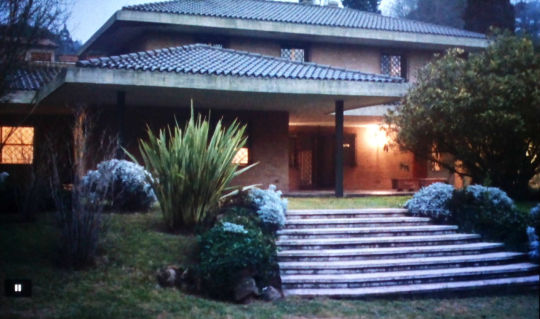
A Blade in the Dark is a 1983 giallo by Lamberto Bava which doesn’t exactly disgrace itself, but nor is it as flamboyantly trashy as you might expect from the director of the nonsense classic Delirium (1987). It’s like Delirium’s better behaved but far duller cousin. While A Blade in the Dark doesn’t make you want to run around without your trousers on, nor does it make you want to take up golf. It’s…okay. Much like the house most of the movie is set in, A Blade in the Dark possesses too many vacant stretches for comfort, but every now and again there’s an item of interest that makes you glad you bothered. Sometimes it’s a gruesome kill, sometimes it’s something agreeably ridiculous like a small kid in a bad wig, sometimes it’s something heart swellingly surreal like an indoor rain of tennis balls, sometimes it’s just the hope that Bruno will change his jumper, but there’s usually something to keep you awake before too long. True, the movie title does fib about the dark; it’s not actually very dark, even at night; but there is definitely a blade or two, and that’s’ what matters in a giallo. Well, it’s hardly nut-tight plotting and believable characters that matters, is it now? C’mon.
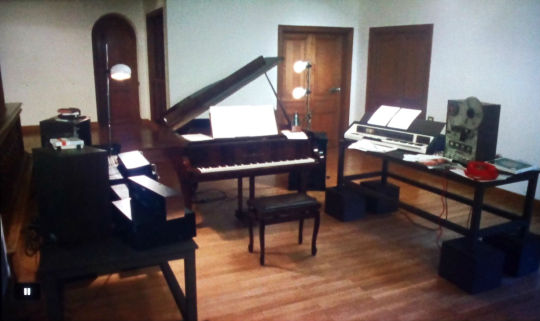
So, in case you were wondering what the set-up is…Bruno (Andrea Occhipinti), a somewhat dull witted composer with bad taste in jumpers, rents a large house from twitchy Tony Rendina (Michele Soavi) in order to work on the score to a giallo, but soon finds his work rate impaired by a series of bizarre occurrences. Occurrences which strongly suggest someone is bumping off young women in the house whenever his back is turned. With a singular lack of bodies and only a slashed up spank mag and a bunch of suggestive blood stains to back him up, Bruno decides not to contact the police but instead raises his concerns with the two people he knows and the gardener, who all basically tell him he’s soft in the head. Bruno might not be a very exciting person but he could have a point. Why do female visitors mysteriously disappear? Why is there blood on the bushes and in the bathroom? Who is the mysterious Linda? What’s that stink coming out of the pool filter? Why would anyone keep a suitcase full of tennis balls? Who rents out a house this badly furnished? Is Bruno just a morbid bugger or is there (da-da-DA!!) really a killer in the house? [Spoiler: there’s really a killer in the house.]

In my defence, it’s not much of a spoiler as we see the murders in all their gory glory. Bruno is a singularly unimaginative man so it’s never in doubt that this is really happening; this isn’t one of those tricksy movies where it’s all going on in someone’s mad head. No, A Blade in the Dark is not exactly unpredictable plot-wise. You will probably guess who the killer is, but you will fail to guess why, as the explanation is as rewardingly “say what now?!?” as in any giallo worth its ketchup. A Blade in the Dark might have a noticeable tension deficiency, but it sure has some murders in it. Without wishing to sound like a thoroughly reprehensible individual, they are quite good murders too; even if the build ups are a bit too long-winded. There’s only so much panicked running away you can watch without starting to suspect the victim’s heart really isn’t in this getting away lark. Eventually, though, the killer corners them and gets stuck in, usually with a craft-knife. This is the killer’s preferred weapon, mainly because it’s available; like many composers Bruno has one lying about along with his spank mags on his work desk. (Oscar® winning movie score composer John Williams never starts a score without a copy of Juggly Wugglies and a craft-knife to hand.) But the killer isn’t too fussy and if a massive kitchen knife, a wrench or a spool of film is at hand then that’ll do. A good giallo killer should always be adaptable.

A Blade in the Dark was originally made for Italian TV so I was a bit taken aback by the levels of violence on show. Nowadays, sure, anything goes. “Won’t anyone think of the children!”; it’s the end of decency and humanity, blah, blah, and all that. But back in 1983 I’m not sure television was ready for a scene where a woman’s hair washing is interrupted by a knife through the hand, a bag over her face and a repeated and very determined face-sink interaction. Turns out, television wasn’t ready for that, so I win that one. Originally filmed as four half-hour parts of a TV mystery series (Brutal Lady Murder Mystery Half Hour?), with each part ending with a murder, A Blade in the Dark logistically requires a minimum of 4 murders. But Bruno only knows 2 women - his scatty actress girlfriend Julia (Lara Lamberti) and the oddball director of the giallo he’s working on, Angela (Fabiola Toledo).

Julia likes to show up unannounced, sex Bruno up and tell lies, while Angela, like many movie directors no doubt, thinks ringing Bruno up and threatening to kill him in a creepy voice is a real thighslapper of a joke. Obviously both these ladies are a bit freak-ay and thus squarely in the frame as the craft-knife wielding killer, so to maintain the suspense someone else has to get slaughtered upfront. Luckily the house has a swimming pool. As we all know swimming pools attract young women like inappropriate internet content attracts men. And you never know when a young woman might fall out of a cupboard, for reasons even she seems unsure of. By hook or by crook A Blade in the Dark gets its murders in. Basically, it’s the kills that lift A Blade in the Dark out of mediocrity. Well, the kills and one other thing. Surprisingly this thing turns out to be a lively, self-deprecating intelligence.
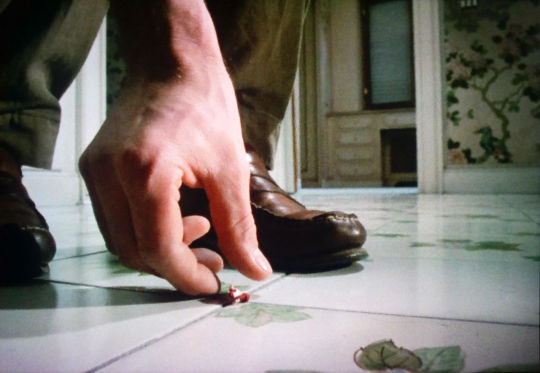
While A Blade in the Dark’s TV origins might lead you to expect an approach as dull as Bruno’s jumper, that’s misleading. It certainly caught me quite off guard with the first trick it plays (no spoilers), but that isn’t the only trick this cheeky monkey plays; which is even more surprising. Because, for reasons known only to itself, A Blade in the Dark gets a bit meta, which is fun; it’s even more fun because it just can’t quite manage to pull it off. That’s okay, when meta works it always feels a bit smug; wonky meta is way better. I like my meta a bit rough round the edges, but that could just be me. The crux of the meta is the movie within the movie. Crucially, the movie Bruno is scoring and Angela is directing may contain the key to the mystery. It definitely contains Giovanni Frezza, who has now appeared in so many movies I’ve watched recently (Demons, The House by the Cemetery and this one) I fear he may be haunting me, like that guy in Wes Craven’s Shocker (1986).
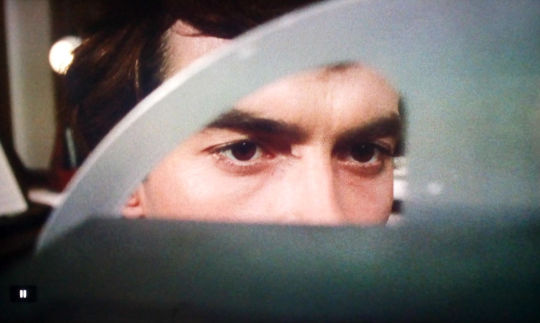
But I digress, the line between that in-movie movie and the movie you are watching is blurred occasionally to enjoyably disquieting effect. Mostly A Blade in the Dark does this by having a bit of fun via Bruno’s music, with that diegetic and non-diegetic business people like to go on about to look smart, and then they wonder why no one invites them to parties. There’s no consistency or real point to A Blade in the Dark’s metatastic boondogglery, but it is fun. Basically, its reach exceeds its grasp, but, hey, points for trying. (NB: If you want to watch a meta-(neo) giallo where the meta actually works (and without any smuggery) then see Berberian Sound Studio (2012)). As TV shows rejigged into movies go, A Blade in the Dark is no Mullholland Drive (2001) but it is just luridly nonsensical enough to be a decent giallo. And there ain’t no harm in that.
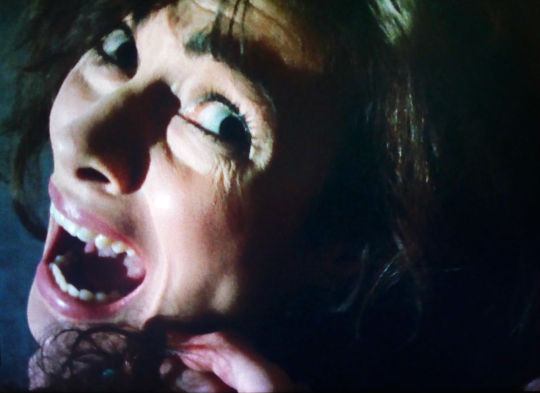
#movies#horror#giallo#italy#the 1980s#1983#lamberto bava#a blade in the dark#la casa con la scala nel buio#andrea occhipinti#lara lamberti#michele soavi#fabiola toledo
0 notes
Text
(Italia 1989, 98’, C)
Regia di Lamberto Bava,
Sceneggiatura di Massimo De Rita e Giorgio Stegani dal racconto di Nikolaj V. Gogol’ Vij, 1835 (Il Vij, Rizzoli, 2002).
Con Giovanni Guidelli, Debora Caprioglio, Stanko Molnar, Mary Sellers, Alessandra Bonarotta, Laura Devoti, Michele Soavi, Eva Grimaldi.
Questo film di Lamberto Bava è il remake televisivo (prodotto dalla berlusconiana Reteitalia) di uno dei capisaldi della filmografia horror/gotica italiana, realizzato proprio dal figlio del regista Mario Bava, autore dell’originale La maschera del demonio nel 1960. Nonostante i titoli del film recitino sia ispirato al racconto Il Vij (così come quello del Bava padre), in realtà la storia si allontana dallo scritto di Nikolai Gogol’ in maniera ancora più netta di quanto non aveva già fatto la pellicola originale.
Un gruppo di sciatori precipita in un crepaccio e trovano una donna congelata con il volto coperto da una strana maschera di ferro. Senza farsi particolari problemi, i ragazzi rimuovono la maschera, letteralmente conficcata nel volto del cadavere per mezzo di spuntoni, e iniziano a giocarci. Un’altra voragine si apre a quel punto, rivelando un passaggio che li porterà in un inquietante villaggio abitato solamente da un prete cieco e dal suo cane. Il religioso racconta loro che il corpo trovato nel crepaccio appartiene ad Anibas (Eva Grimaldi), una strega sfuggita al rogo ma rimasta congelata tra i ghiacci della montagna. La maschera le era stata applicata prima dell’esecuzione per imprigionare il suo influsso malefico, adesso che i ragazzi gliela hanno strappata dal viso, lei è libera di tornare in vita impadronendosi del corpo di Sabina (il nome di Anibas scritto al contrario), una delle ragazze del gruppo interpretata da Debora Caprioglio (all’epoca compagna dell’attore Klaus Kinski e nei titoli di testa compare come Debora Kinski).
Come si può intuire dalla trama, il film prende le distanze anche da quello di Bava senior. Dall’ottocentesca campagna russa si passa alle montagne della Svizzera contemporanea. L’originale era girato in un evocativo bianco e nero, questo ha i colori saturi di una réclame pubblicitaria anni ottanta. All’atmosfera gotica che lo permeava si aggiunge, un po’ alla rinfusa, tutta quell’estetica horror che si è aggiunta al genere nei trentanni che separano i due film: interpreti poco più che adolescenti, esorcismi; effetti splatter. Nel film originale, sia la strega sia la ragazza posseduta erano interpretate dalla stessa attrice, la regina del gotico Barbare Steele, qui invece a interpretare i due personaggi sono due attrici diverse, perdendo così tutti quei richiami al tema del doppio. A richiamare il racconto di Gogol’ solo qualche citazione disseminata qua e la, come la scena in cui uno dei ragazzi rimane a vegliare sul corpo della strega, e poco altro.
Numerosi sono i tasti dolenti di questa produzione con cui il regista intendeva regalare il padre. Prima di tutto la sceneggiatura è abbastanza pasticciata, alcuni comportamenti dei protagonisti appaiono spesso incoerenti. Il versante recitativo, tra starlette televisive del momento, attori esordienti e altri non molto dotati, non è tanto più incoraggiante (tra gli interpreti, da segnalare la presenza del futuro regista de La chiesa e Dellamorte Dellamore, Michele Soavi). Un prodotto tipico, in definitiva, del periodo in cui fu realizzato, simile ad altre produzioni televisive Fininvest del genere (spesso realizzate dallo stesso Bava jr.) e che suggellarono il definitivo tracollo del cinema horror italiano, un tempo florido di idee e film.
VIY-LA MASCHERA DEL DEMONIO
LA MASCHERA DEL DEMONIO, l’omaggio (non molto riuscito)di un figlio al padre. (Italia 1989, 98’, C) Regia di Lamberto Bava, Sceneggiatura di Massimo De Rita e Giorgio Stegani dal racconto di Nikolaj V.
1 note
·
View note
Photo










Macabre (1980)
294 notes
·
View notes
Photo

macabre
3 notes
·
View notes
Photo










Macabre (1980)
Lamberto Bava
15 notes
·
View notes


